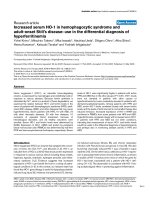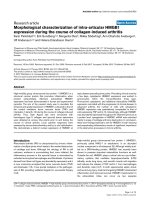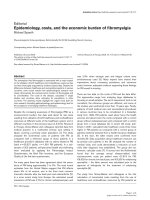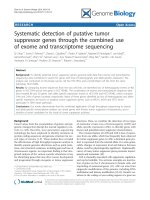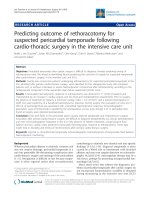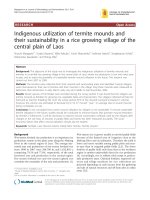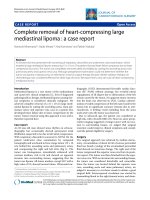Báo cáo y học: "Hospital costs of central line-associated bloodstream infections and cost-effectiveness of closed vs. open infusion containers. The case of Intensive Care Units in Italy" ppsx
Bạn đang xem bản rút gọn của tài liệu. Xem và tải ngay bản đầy đủ của tài liệu tại đây (261.28 KB, 10 trang )
RESEARC H Open Access
Hospital costs of central line-associated
bloodstream infections and cost-effectiveness
of closed vs. open infusion containers. The case
of Intensive Care Units in Italy
Rosanna Tarricone
1
, Aleksandra Torbica
1*
, Fabio Franzetti
2
, Victor D Rosenthal
3
Abstract
Objectives: The aim was to evaluate direct health care costs of central line-associated bloodstream infections
(CLABSI) and to calculate the cost-effectiveness ratio of closed fully collapsible plastic intravenous infusion
containers vs. open (glass) infusion containers.
Methods: A two-year, prospective case-control study was undertaken in four intensive care units in an Italian
teaching hospital. Patients with CLABSI (cases) and patients without CLABSI (controls) were matched for admission
departments, gender, age, and average severity of illness score. Costs were estimated according to micro-costing
approach. In the cost effectiveness analysis, the cost component was assessed as the difference between
production costs while effectiveness was measured by CLABSI rate (number of CLABSI per 1000 central line days)
associated with the two infusion containers.
Results: A total of 43 cases of CLABSI were compared with 97 matched controls. The mean age of cases and
controls was 62.1 and 66.6 years, respectively (p = 0.143); 56% of the cases and 57% of the controls were females
(p = 0.922). The mean length of stay of cases and controls was 17.41 and 8.55 days, respectively (p < 0.001).
Overall, the mean total costs of patients with and without CLABSI were € 18,241 and € 9,087, respectively (p <
0.001). On average, the extra cost for drugs was € 843 (p < 0.001), for supplies € 133 (p = 0.116), for lab tests € 171
(p < 0.001), and for specialist visits € 15 (p = 0.019). The mean extra cost for hospital stay (overhead) was € 7,180
(p < 0.001). The closed infusion container was a dominant strategy. It resulted in lower CLABSI rates (3.5 vs. 8.2
CLABSIs per 1000 central line days for closed vs. open infusion container) without any significant difference in total
production costs. The higher acquisition cost of the closed infusion container was offset by savings incurred in
other phases of production, especially waste management.
Conclusions: CLABSI results in considerable and significant increase in utilization of hospital resources. Use of
innovative technologies such as closed infusion containers can significantly reduce the incidence of healthcare
acquired infection without posing additional burden on hospital budgets.
Background
Considering the rapid pace of innovation in the health-
care arena, an ever-increasing number of strategies for
detection, prevention and treatment of diseases are
expected in the market. However, budgetary constraints
always make it more challenging for policy makers to
finance technological innovation in healthcare.
Identifying the optimal allocation of available resources
in order to maximize health gains in the patient popula-
tion is a continuous challenge to health-care system sus-
tainability. The dilemma of whether to invest in a new
technology or expand existing program to a wider target
population is universal. In making those judgments,
decision makers apply differing criteria and rely on var-
ious sources of information. Economic evaluation analy-
sis, together with assessment of clinical effectiveness,
* Correspondence:
1
CERGAS-Bocconi University, Via Roentgen 1, 21036 Milan, Italy
Tarricone et al . Cost Effectiveness and Resource Allocation 2010, 8:8
/>© 2010 Tarrico ne et al; licensee BioMed Central Ltd. This is an Open Access article distributed under the terms of the Creative
Commons Attribu tion License ( which permits unrestricted use, distribution, and
reproduction in any medium, provided the origina l work is properly cited.
supports decision making processes in public domain by
providing necessary information concerning the eco-
nomic aspects of resource absorption by different
healthcare technologies.
Healthcare-associated infections (HAIs) are one of the
most serious patient safety issues in healthcare today,
affecting over 1.4 million people worldwide (Global
Patient Safety Challenge, 2005-2006, World Health
Organization). Even though the principal risk factors
and appropriate prevention methods have been identi-
fied in the past decades, HAIs continue to present one
of the major public health problems in the world [1].
Sound and abundant evidence demonstrates that HAIs
are associated with increases in morbidity and mortality,
as well as greater costs of hospitalization and overall
medical care [2-9].
In the United States, the incidence of HAIs has been
estimated at 2 million cases per annum, causing
approximately 90,000 deaths and imposing an annual
financial burden of 6.5 billi on dollars [1,10]. In England,
it is estimate d that about 320,000 pa tients acquire one
or more infections during hospitalization per annum,
costing the National Health Service as much as £1 bil-
lion a year [11]. In Italy, every year 450,000-700,000
patients acquire infections while in the hospital; in other
words, 5 to 8 of 100 hospitalized patients contract a
HAI. A few studies have estimated the clinical burden
of HAIs, but the evidence regarding the economic
impact is currently very limited [7,12]. It was estimated
that the economic burden of these infections is equal to
1.0% of total National Health Service expenditure [5,7].
Zotti and colleagues prevalence of HAI was 7.84%, with
marked differences among the participating hospitals
(range: 0-47.8%). The authors concluded that patients
with HAI on averag e experience longer hospit al lengths
of stay. Nevertheless, no data was provided in support
of that conclusion. Another study investigated the
longer hospital stay and extra direct costs of all hospi-
tal-acquired laboratory confirmed bacteremia in a 2000-
bed teaching hospital. The r esults showed that HAIs
prolonged hospital s tay by approximately 20 days and
increased direct costs by € 16,536 per case [7].
The highest rate of majority of HAIs occurs in inten-
sive care units (ICUs), and most are associated with the
presence of invasive devices such as a central line (CL)
or mechanical ventilator [13]. Several million intravascu-
lar devices are purchased each year by hospitals and
clinics as they are indispensable for administering life-
saving therapies to critically ill patients. However, their
use may put patients at risk of local and systematic
infectious complications, including both localized site
infections and central line-associated bloodstream infec-
tions (CLABSI). Nearly 1 of 4 catheterized patients with
a central line in place for an average of 8 days is
expected to develop catheter colonization, which
increases the risk of more s erious bacteremia [14,15].
Rosenthal et al showed that ventilator-associated pneu-
monia and CLABSI represented more than 70% o f all
device-associated infections in 55 ICUs in 8 countries
(41% and 30%, respectively) [16].
CLABSI infections not only complicate illness, but can
lead to disability and even death. The mortality attribu-
table to CLABSI was estimated to range between 12 to
25% in several studies [17-20]. In addition, there is a
considerable amount of evidence demonstrating that
CLABSIs are associated with significant increases in
the length of hospital stay and medical care costs
[2,8,16, 21-25]. Numerous strate gies have been evaluated
to reduce the clinical and econom ic burden of CLABSI,
such as the use of silver or antiseptic impregnated
catheters, cutaneous antisepsis and antimicrobial lock
solutions [26]. There is growing evidence that imple-
mentation of a “bundle” of multiple interventions can
markedly reduce rates of CLABSI [27]. These bundles
may include both behavioral (e.g., maximal sterile bar-
rier precautions, catheter placement and optimal timing
of replacement, surveill ance, education, improved hand
hygiene [HH] technique and compliance, etc.), and tech-
nological (e.g., use of preferred skin antiseptics such as
chlorhexidine gluconate, closed infusion containers,
catheter dressings, etc.) practices. Catheter audit pro-
grams have also been used to review clinical practice
associated with the insertion and subsequent care of
CLs and their possible relationship to the development
of HAI [28].
The use of innovative, “closed” infusion containe r has
shown to have remarkable impact in reducing the inci-
dence of CLABSI [29]. Closed infusion containers con-
sist of fully collapsible plastic containers that do not
require or use any external vent (air filter or needle) to
empty the solution, and have injection ports that are
self-sealing. Alternatively, the traditional open infusion
container consists of rigid (glass, burette) or semi rigid
plastic containers that must admit air to empty (air filter
or needle) [16]. The risk of contam ination and ad minis-
tration-related BSI is increased with open infusion con-
tainers that permit air, and potentially microorganisms,
to enter. Innovative closed infusion containers have
been developed to reduce this risk.
While open infusion containers have been used world-
wideforover75years,theyhavebeensupplantedby
closed containers throughout North America and Wes-
tern Europe. Open containers are still widely used in
Latin America, Asia, Eastern Europe, Germany and Italy.
Italy is one of the few Western Europ ean countr ies that
mainly use o pen, externally vented glass or semi-rigid
infusion containers. At present, there is no empirical
evidence available regarding the economic and clinical
Tarricone et al . Cost Effectiveness and Resource Allocation 2010, 8:8
/>Page 2 of 10
impact of the introduction of closed infusion containers
into clinical practice in Italy.
In order to allow hospital managers to identify the
most convenient strategies for reducing the impact of
HAIs, it is important to provide reliable data on the
costs borne by the hospital for CLABSI and on the cost
opportunity to i mplement an innovative technology
aimed at reducing the burden. The present study was
designed to meet these two objectives: (1) to measure
and evaluate the direct health care costs of CLABSI and
(2) to calculate the cost-effectiveness ratio of the closed
vs. open infusion container in a hospital setting.
Methods
Study design
In order to measure the direct health care costs of
CLABSIs, a case-control study was performed in a 500-
bed teaching hospital Sacco in Milan, Italy. Table 1
reports data about the size of the hospital and its activ-
ities in comparison to other public hospitals in the Lom-
bardy region and in Italy. The Sacco Hospital can be
considered representative of other hospitals in the
region in terms of size and act ivity (number of inpatient
admissions) and type of patients treated (case-mix)
(Table 1).
The cost analysis was conducted alongside a prospective
surveillance cohort study aimed at measuring the
CLABSI rates of the two infusion containers. The study
included four ICUs in the h ospital: Coronary (UCC),
Post-Acute (TIPO), General (RIA) and Infectious Dis-
eases (ID). The perspective of the analysis was that of
the hospital. The detailed methodology of a surveillance
study has been published elsewhere [30]. For clarity and
completeness, we here shortly present the methods rele-
vant for the economic part of the analysis.
The study was conducted in three sequential phases:
1) Phase 0 (lead-in phase): from November 2003 to
February 2004. In this phase, healthcare professionals
working in the four ICUs were trained to comply with
proper HH and CL care.
2) Phase 1 (open infusion container): from March
2004 to February 2005. In this phase, the current open
drug delivery container (glass) was used on all patients
admitted to the four ICUs and enrolled in the study.
3) Phase 2 (closed infusion container): from March
2005 to February 2006. In this phase, the innovative,
closed drug delivery container (Viaflo® flexible bags) was
introduced and used for all patients admitted to the
four ICUs and enrolled in the study.
The following controls were implemented to minimize
the effect of confounding factors inherent in the sequen-
tial comparison design of the study: no new infection
control interventions, training programs, products or
technologies were introduced during the study periods
and all of the investigators, key study personnel, classifi-
cationsanddiagnosticstechniquesremainedconstant
throughout the entire study. The time effect was miti-
gated by equal 12-month periods covering all seasons of
the year. A lead-in period was performed to standardize
HH and CL care compliance practice.
During all phases of the study, active prospective
monitoring of HH and CL care compliance (i.e. place-
ment of gauze of CL insertion sites , conditions of gauze
dressing - absence of blood, moisture and gross-soiling;
occlusive coverage of insertion site - and documentation
of date of CL insertion) was conducted and healthcare
professionals were regularly informed about their perfor-
mance. Once the level of compliance set up by the study
protocol was achieved (≥ 95% and ≥ 70% for CL care
and HH compliance, respectively), the four ICUs could
begin to enroll patients (phase 1) [30].
The distinction among t he three phases was relevant
for the cost-effectiveness part of the economic analysis,
since the effectiveness of the two infusion containers
was measured in terms of CLABSI rate incurred in the
two periods (phase 1 and phase 2), as explained below.
As to the cost analysis of CLABSI, it was assumed that
the cost of HAI does not vary across phases; therefore,
patients for the cost analysis were enrolled throughout
the entire study period.
All adult (>18 years of age) patients admitted to the
four ICUs with CL in place for the administration of
fluids for at least 24 hours were eligible for recruitment.
Exclusion criteria included day-hospital patients;
patients receiving chronic antibiotics (3 weeks or longer)
and presence of other major HAI such as ventilator-
associated pneumonia and c atheter-associated urinary
tract infections.
Data were prospectively collected at admission and
included patient demographics (sex, age, and employ-
ment status), clinical variables (underlying disease: pri-
mary and secondary diagnosis at admission, average
Table 1 Study site characteristics in comparison to all
public hospitals in Lombardy and Italy
Sacco
Hospital
Lombardy
Region
Italy
Size
n. of inpatient beds 522 542 289
n. of day hospital
beds
66 58.4 34
N. of admissions in 2005
inpatient 16,322 18,791 10,785
day hospital 1,231 2,783 1,342
Average LOS in 2005 10.6 12.31 11.08
Case mix index 1.11 1.07 1
LOS = length of stay
Tarricone et al . Cost Effectiveness and Resource Allocation 2010, 8:8
/>Page 3 of 10
severity of illness score [ASIS] [31], type of admission
(medical vs. surgical), the placement or removal of CL,
number of CL days, presence and type of CLABSI), as
well as ICU admission and discharge dates.
Patients who developed CLABSI while in ICUs in the
study period were classified as “cases”.Formultiple
admissions and/or multiple infections, only the first ICU
admission and/or HAI episode was considered. Patients
who did not develop CLABSI at anytime during their
stay in any of the four ICUs were eligible to serve as
controls, but before being selected they were matched
to cases on the basis of the following five variables: 1)
sex; 2) age (± 5 years); 3) ASIS (± 1 point); 4) admission
department; and 5) type of admission (surgical vs. medi-
cal). Patients had to match exactly on all f ive variables
to become controls. Each case was matched with at
least 2 controls.
Resources Consumption and Cost Estimation
Once the cases and controls were identified, further data
on consumption of resources were collected and the full
costing method was used to evaluate patient admissions.
Resources were classified as direct, if the consumption
was entirely attributable to the patient’s hospital stay;
indirect, if it was difficult to trace the consumption to
the patient (e.g., heating, cleaning); and overhead,ifit
was impossible to attrib ute the consumption to any spe-
cific patient (e.g., administration costs). The consump-
tion of resources was measured through a bottom-up
approach, by going through each individual patient.
Direct resources were evaluated in monetary terms
through a micro-costing approach, where quantities and
unit costs were first estimated and then multiplied);
indirect resources and overheads were estimated through
a gross costing m ethod and were allocated to patients
by length of stay.
Data on the quantity and type of direct resources used
while in hospital were collected at the patient level
through a purposely designed questionnaire (Economic
Form) and included: 1) pharmaceuticals including anti-
biotics; 2) laboratory tests; 3) diagnostic tests; 4) medical
procedures; 5) surgical interventions; 6) specialist visits;
and 7) medical supplies.
Unit costs for the majority of direct resources were
provided by the Account ing Department of the Sacco
hospital (points 1, 2, 3, 6 and 7 above). When unit costs
were not available (4 and 5 above), the regional tariffs
were used. If there were different types of the same
resource (i.e., different types of catheters, tubes, etc.),
weighted unit costs adjusted by market share were used.
Indirect costs and overheads were calculated at the
ICU level and allocated to patients on the basis of their
length of st ay. These cost categories referred to: depart-
ment personnel cost including medical doctors, nurses
and other professionals; maintenance and equipment
repair costs; depreciation costs; administration costs;
and hotel costs such as laundry, meals, cleaning, etc.
In the cost-effectiveness analysis, both the direct and
indirect components of the production costs of the two
infusion containers were evaluated, and the dif ference
was then calculated. A study specific questionnaire was
prepared and submitted to the Chief of the Hospital
Pharmacy Department. Through the use of the ques-
tionnaire, it was possible to identify the cost function of
either container in terms of time spent by pharmacists,
supplies, wastage, storage, transportation and adminis-
tration. The unit costs were provided by the Hospital
Pharmacy and the Accounting Department. According
to the data provided, 1 cent m ore was applied to the
unit cost of the closed container.
Finally, the incremental cost between the two infusion
containers was then compared to the incremental effec-
tiveness of the closed vs. open container. The effective-
ness was measured in terms of CLABSI rate (number of
CLABSI per 1000 CL days in phase 1-open infusion con-
tainer, vs. phase 2-closed infusion container). In other
words, the incremental effectiveness of the closed con-
tainer was the “number of CLABSI infections avoided” by
switching from one infusion container to another.
Data Analysis
All statistical analyses were performed using the soft-
ware STATA 9.0 (Stata Corp. , College Station, TX,
USA). Means with standard deviations were used to
describe continuous variables, while medians were cal-
culated for non-normal distributed continuous variables.
Clinical and demographic differences between the two
groups (cases and controls) were analyzed by performing
Student t-test. For categorical variables, a Chi-squared
test was used.
The cost of one CLABSI was calculated as the differ-
ence in costs between patients w ho developed CLABSI
(cases) and those who did not get infected (controls),
after matching for selected v ariables. A two-sided p value
of < 0.05 was deemed to be statistically significant.
A multiple regression model was used to assess the
impact of CLABSI on total healthcare costs. More speci-
fically, the regression was preliminarily run by includ ing
all variables that were aprioribelieved to be predictors
of costs: age, sex, ASIS, department and type of admis-
sion. The categorical variables were included in the
model as dummy variables. A backward stepwise
approach was used, where the model was refined by
eliminating coefficients with p values higher than 0.05.
Due to its non-normal distribution, the natural log of
cost was used as the dependent variable [32,33]. A sce-
nario analysis was performed using different incremental
effectiveness rates.
Tarricone et al . Cost Effectiveness and Resource Allocation 2010, 8:8
/>Page 4 of 10
Results
Characteristics of the Sample
A total of 14 46 patients were enrolled in the study: 273
patients in Phase 0, 608 patients in Phase 1 and 565
patients in Phase 2. The majority of patients were males
(67%), with a mean age of 65.5 years. Medical admissi ons
accounted for approximately 75% of hospitalizations.
CLABSI occurred in 43 patients (7, 29 and 7 in three
phases respectively); one patient developed two episodes
of CLABSI, and the second episode was excluded from the
study. Laboratory confirmed bloodstream infection
accounted for 18 cases (42%), while the rest of the cases
were diagnosed as clinical sepsis. The overall incidence of
CLABSI was 6.14 infections per 1000 CL days, and the CL
was in place for an average of 6 days per patient. A total of
97 patients were selected as controls (21, 55 and 21 in
three phases respectively). The two groups were perfectly
comparable; no significant difference was found for age,
sex, department, type of admission and ASIS (Table 2).
Cases stayed in the hospital significantly longer than
controls; length of stay for cases was approximately two-
fold higher than for controls (17.41 days vs. 8.55 days;
p < 0.0001). This result varied greatly among different
ICUs, ranging from 4.21 extra days in the UCC to 11.09
extra days in the RIA (Table 3).
Total direct healthcare costs per patient resulted in
€ 18,241 for cases and € 9,087 for controls. The differ-
ence between the two groups was statistically significant
in all cost categories with the exception of medical pro-
cedures, supplies and surgical interventions, due to the
small number of patients receiving them in both groups .
The difference was particularly evident for drugs, labora-
tory test and specialist visits. As to drugs, the total cost
for cases was 2.7 times higher than for controls, with
almost two-fold costs associated with antibiotics.
Laboratory test costs were si gnifica ntly higher (+180%)
for cases as well as cost for specialist visits (+140%). In
both groups, length of stay represented the most signifi-
cant cost component: 78% and 77% of the overall costs
for cases and controls, respectively. Because of the
greater length of stay for cases, the extra hospital stay
cost attributable to CLABSI was € 7,180 (Table 4).
The extra cost attributable to CLABSI was € 9,154 (p <
0.0001) ranging f rom € 14,757 (p < 0.0001) in the RIA
to € 456 (p = 0.1931) in the UCC due to t he low num-
ber of cases (Table 5).
These findings were tested in a multiple regression
model. The model was robust; it explained almost 50%
of total cost variability (R
2
= 0.4485). The regression
analysis showed that three variables had a significant
impact on costs: ASIS, department type and presence of
infection. On average, total costs increase by 12.78% per
each incremental ASIS grade (coefficient = 0.1278). For
CLABSI, the coefficient of 0.673 implies that on average,
tot al hospital costs increase by 67.3% in the presence of
this type of HAI (Table 6).
Cost-Effectiveness of Closed vs. Open Infusion Container
The closed infusio n container was more effective than
the traditional open container. The number of CLABSI
per 1000 CL days in the closed infusion container phase
was significantly lower than in the open container phase
(3.5 vs. 8.2 p = 0.01). The relative risk (RR) was 0.43
with a 9 5% confidence interval (CI = 0.22 - 0.84) [30].
Thus, the i ncremental effectiveness of the closed infu-
sion container was 4.7 C LABSI avoided per 1000 CL
days. This result was assessed against the incremental
costs in order to calculate the incremental cost-effective-
ness ratio.
For the majority of cost components evaluated in the
questionnaire, there was no measurable difference
between the two infusio n containers (Table 7). Manage-
ment of orders, storage space and transportation from
the store room to the department did not differ between
Table 2 Sample characteristics
Cases (N = 43) Controls (N = 97) P value
Age
Mean (std. dev.) 62.1 (16.8) 66.6 (16.2) 0.143
Gender
female 24 (56%) 55 (57%) 0.922
male 19 (44%) 42 (43%)
Professional status
employed 14 (33%) 22 (23%) 0.319
retired 25 (58%) 69 (71%)
unemployed 4 (9%) 6 (6%)
ASIS
1 5 (12%) 19 (20%) 0.397
2 13 (31%) 28 (30%)
3 7 (17%) 21 (23%)
4 14 (33%) 18 (19%)
5 3 (7%) 7 (8%)
Department
UCC 4 (9%) 10 (10%) 0.897
TIPO 12 (28%) 26 (27%)
RIA 15 (35%) 39 (40%)
ID 12 (28%). 22 (23%)
Type of admission
surgical 3 (7%) 9 (9%) 0.654
medical 40 (93%) 88 (91%)
Type of BSI
lab confirmed 18 (42%)
clinical sepsis 25 (58%)
Test Chi-2 for categorical variables, Student t test for normally distributed data
and Mann Whitney U test for ordinal and non-normally distributed (skewed)
data.
Tarricone et al . Cost Effectiveness and Resource Allocation 2010, 8:8
/>Page 5 of 10
the two containers. Storage place was not a scarce
reso urce for the Pharmacy Department which had suffi-
cient room to store either bottles (more voluminous) or
plastic bags. In other words, the opportunity cost to
store bottles was null for the Pharmacy Department at
Sacco hospital. The use of the innovative closed infusion
container technology did not have any impact on th e
transportation of supplies from storage to the hospital
departments since the service is outsourced and paid for
by Sacco hospital according to predefined fixed hourly
fees, which do not vary by the amount and/or weight of
supplies transferred. Therefore, no difference could be
found between the two containers for storage and trans-
portation costs from the hospital perspective.
A small difference was foun d in the cost of disposables,
preparation and administration of the two infusion con-
tainers (Table 7). The difference relates to cost of dispo-
sables (plastic bag vs. glass bottle, needles, alcohol,
swabs, etc.). The time needed to prepare the intravenous
drug delivery container was estimated to be equivalent
(1.5 minutes) by the Chief of the Pharmacy Department,
regardless of the type of container used. The administra-
tion time was estimated to be 5 minutes in both cases.
The most relevant difference between the two infusion
containers was observed in the management of waste.
This difference is directly correlated with the weight of
plastic bags vs. gl ass bottl es, which for the same volume
of liquid is approximately 10 times heavier for the glass
bottles than the plastic bags. The cost of wa ste manage-
ment is therefore significantly lower for the closed con-
tainer (Table 7).
In order to measure the level to which the difference
in production cost of the two infusion containers could
increase while leaving the hospital cost neutral, a sce-
nario analysis was performed. Two scen arios were envi-
saged on the basis of the incremental effectiveness of
the closed container, corresponding to the lower and
upper limit of the 95% confidence interval obtained in
Table 3 Mean (median) length of stay by Intensive Care Unit (days)
Intensive Care Unit Cases (N = 43) Controls (N = 97) Difference in means (days) P value*
UCC 11.25 7.40 4.21 0.19
(n = 14, 4 cases) (9.50) (7.50)
TIPO 11.66 5.53 6.13 <0.001
(n = 38, 12 cases) (10.50) (5.00)
ID 21.58 12.13 9.45 0.002
(n = 34, 12 cases) (20.00) (9.50)
RIA 20.33 8.84 11.09 <0.001
(n = 54, 15 cases) (20.00) (8.00)
Overall 17.41 8.55 8.46 <0.001
* Mann Whitney test
Table 4 Unit cost, number of users and mean cost per patient in different cost categories
Cost
Category
Average unit cost per
category
Total n. of user
(% of total sample)
Cost by cases
(% of total costs)
Cost by controls
(% of total costs)
Δ (Δ/controls) P value*
Drugs 3.91 139 1,158 (6%) 315 (3%) 843 (2.7) 0.000
Antibiotics 2.76 108 477 (3%) 178 (2%) 299 (1.7) 0.000
Supplies 34.5 140 407 (2%) 274 (3%) 133 (0.5) 0.116
Medical procedures 785.6 38 130 (1%) 301 (3%) -171(-0.6) 0.899
Surgeries 5968 32 1,728 (9%) 904 (10%) 824 (0.9) 0.607
Diagnostic tests 64.24 137 391 (2%) 232 (3%) 159 (0.7) 0.009
Lab exams 12.4 134 264 (1%) 93 (1%) 171 (1.8) 0.000
Special visits 16.53 55 26 (0%) 11 (0%) 15 (1.4) 0.019
Hospital stay
TIPO 1140.07 14,137 (78%) 6,957 (77%) 7,180 (1.0) 0.000
ID 350.91
RIA 1090.68
UCC 550.11
Total Direct Healthcare Costs 18,241 9,087 9,154 (1.0) 0.000
* Student t test on log transformed data
Tarricone et al . Cost Effectiveness and Resource Allocation 2010, 8:8
/>Page 6 of 10
the surveillance study (RR = 0.43; 95% CI = 0.22-0.84)
[30]. In both scenarios, the calculations were performed
for 500 catheterized patients for a total of 3000 CL days
(average number of patients and CL days observed in
thesurveillancestudy)[30].Thebaselinewas8.2
CLABSI per 1000 CL days for the open infusion con-
tainer phase. In a conservative assumption, only the
direct costs of CLABSI are considered to be avoidable in
short term. In less conservative assumption, all costs are
deemed avoidable in the long run. On th e basis of these
assumptions, direct costs avoided with the closed con-
tainer range from € 15.4 to € 75.8 per patient in the
worst and the best scenarios, respectively. Thus, hospital
coststhatcanbeavoidedintheshorttermrangefrom
€ 7,770 to € 37,800 for every 500 patients catheterized
in the best and the worst scenarios, respectively. In the
less conservative, full costing approach, avoided costs
range from € 72.0 to € 350.8 per patient, or from
approximately € 36,000 to € 175,000 for 500 catheter-
ized patients in the long-run.
These results indicate that the innovative technology
allows for avoiding hospital costs even when the
incremental effectiveness is at its lowest rate. This sug-
gests that even if the difference in acquisition costs of
the two infusion containers had been greater than what
was observed at Sacco hospital, the new technology
would have remained cost-saving.
Discussion
From the results of the study, it clearly emerges that
even a single CLABSI displaces a relevant amount of
hospital resources that could be allocated differently.
This study provides one of the most comprehensive esti-
mates to dat e of the economic burden imposed by
CLABSI occurring in adult patients admitted to ICUs in
Italy. In this study, patients with CLABSI, on average,
incurred hospital costs that were almost two times
higher than those without CLABSI. The majority of the
additional costs incurred were due to a prolonged hospi-
tal stay. The total healthcare cost attributable to CLABSI
averaged € 9,000. These r esults are in line with those
reporte d in the international literature. They are similar,
for example, to those conducted in 309 patients with
HAIs treated in a district hospital in England [11]. The
author of the UK study estimated that CLABSI cases, on
average, had an increased ICU length of stay of 4 days,
with hospital costs 2.9 times higher than uninfected
patients (extra cost of approximately € 10,000). More
recently, Warren and colleagues estimated attributable
costs of CLABSI among ICU patients in a non-teaching
hospital in the United States. The results showed that
CLABSI significantly prolonged hospital and ICU length
of stay by 7.54 and 2.41 days, respectively, with extra
costs of approxi mately $ 11,971 [25]. Finally , our results
are similar to those obtained in a multi-center study
conducted in Calgary, Canada where the median cost
attributable to ICU-acquired CLABSI was $ 12,321 CA
per case [34].
The authors of a recent review on studies investigating
the costs of HAIs conclude that availabl e literature pre-
sents several methodological limitations. According to
the authors, a majority of published studies use crude
costing metho ds, providing only aggregate estimates [1].
Additionally, it may be argued that the for the most part
available studies investigated the impact of HAIs in a
retrospective design and, therefore, relied greatly on the
availability of cost data from the hospital databases.
Table 5 Mean (median) cost per patient by Intensive Care
Unit (€)
Intensive Care Unit Cases Controls Δ in means P value*
UCC 7,694 7,238 456 0.193
(n = 14, 4 cases) (6,703) (6,965)
TIPO 19,293 9,119 10,174 <0.001
(n = 38, 12 cases) (16,842) (8,721)
ID 10,479 5,323 5,156 0.002
(n = 34, 12 cases) (8,747) (4,416)
RIA 26,421 11,664 14,757 <0.001
(n = 54, 15 cases) (24,439) (10,000)
* Student t test on log transformed data
Table 6 Multiple Regression Analysis. Dependent
variable: Log total cost
Independent Variables b T P value
ASIS 0.1278 2.25 0.026
RIA department 0.6152 4.73 0.000
TIPO department 0.6078 4.72 0.000
CLABSI 0.6736 6.65 0.000
N = 140; p < 0.0000; R = 0.5344; R square = 0.4485
Table 7 Production costs of the two drug delivery containers (€)
Production Function Phases Open containers Closed containers
Supplies, preparation and administration costs * 2.98 3.00
Waste management* 0.185 0.0185
Storage management No difference
Transportation to departments Flat rate
* the calculation is based on one dose of NaCl solution 100 ml
Tarricone et al . Cost Effectiveness and Resource Allocation 2010, 8:8
/>Page 7 of 10
The present research represents an attempt to over-
come some of these limitations. First, it is a methodo-
logically rigorous cost analysis, including not only costs
of hospital stay, but also cost of drugs, antibiotics, medi-
cal procedures, surgeries, diagnostic tests, lab exams,
and specialists’ consultations. Second, it is based on pro-
spectively collected data with study specific question-
naire. Furthermore, the micro costing approach allowed
the identification of all resources used by each individual
patient with CLABSI, in terms of types and quantities.
ThesedatamaybeofvaluetootherhospitalsinItaly
and elsewhere to assess, after adjusting for the hospital-
specific unit costs, the economic burden of the infec-
tions in their contexts.
Results confirmed that hospital stay represents the
most significant part o f the overall costs in both cate-
gories of patients, and primarily accounts for the differ-
ence in the incremental costs between the two groups
of patients (17.9 vs. 8.5 days; p < 0.0001). It is important
to underscore that the prese nt research was conducted
from the hospital perspective. It is usually the hospital
rather than society who serves as the decision maker
when it comes to implementing new infection control
interventions such as the use of new drug infusion con-
tainers. Because of this perspective, the time horizon of
the a nalysis is limited to the hospitalization period. It is
arguable, however, that HAIs impose significant burden
in other settings as well. Following discharge, patients
who suffered a HAI might consult primary and commu-
nity care services, such as general practitioners. In addi-
tion to the costs incurred by the healthcare sector, there
may be costs incurred by the patient and informal care-
givers. Further analysis could therefore be considered to
expand the perspective of this analysis.
There are some limitations to this st udy that are
worth mentioning. First, there may have been confound-
ing variables that could have influenced the magnitude
of the findings and for which we did not account. This
type of limitation is typical of observational cohort
designs. For example, severely ill patients are more likely
to remain in the hospital for prolonged periods because
of the severity of illness and not because of HAI. In our
study, the additional costs attributable to CLABSI were
estimated by matching cases t o controls, where the total
healthcare costs of cases and controls were directly
compared and the difference was determined to be the
cost of infection. As these two groups may have differ-
ent characteristics which might impact resource use,
patients with CLABSI were matched with two or more
uninfected controls. This methodology was criticized as
leading to large overestimates for HAI costs due to
biases and confounding variables overlooked in the
matching process [3]. In order to overcome the limits of
matching design, the use of statistical regression analysis
was proposed, wherein the impact of each single vari-
able onto total costs was analyzed with other variables
being equal . These methods reduce, if not eliminate, the
role played by bias and confounding variables [3].
The second objective of the study was to investigate
the incremental cost-effectiveness ratio (ICER) of the
innovative technology from the perspective of the hospi-
tal. Basically, the question was: what is the incremental
cost per avoided CLABSI by switching from the open to
the closed infusion container? To respond to this ques-
tion, an incremental analysis was conducted to measure
and compare the costs and outcomes of the two
containers.
The innovative, closed infusion container was found
to be a dominant cost saving strategy as the adoption of
this container significantly reduced the rate of CLABSI
without increasing hospital costs. Moreover, no mea-
sureable cost difference was obser ved in the production
function of the two containers in the management of
orders, storage space and transportation from the store
room to the departments. Preparation and administra-
tion costs were equivalent. The closed container pre-
sented a significantly lower cost of waste management.
It must be noted that the results obtained in this hospi-
tal may not be entirely representative as to production
cost function in other settings. First, the acquisition
costs of the two containers are not representative of Ita-
lian market prices since they were negotiated at special
conditions to facilitate the conduct of the study. Second,
in other hospitals, it is likely that some cost com po-
nents may decrease by switching f rom the open to the
closed infusion container (e.g., storage and transporta-
tion). Therefore, the dominance of the innovative tech-
nology is likely to be further confirmed if not more
prominent in those hospitals where the storage and
transportation costs do represent an opportunity cost.
In addition, gi ven the estimated full cost of infection of
approximately € 9,000, the dominance of the closed
infusion container would likely be confirmed even at
higher acquisition price of this innovative technology.
Furthermore, the scenario analysis demonstrated that
the dominance of the closed container is maintained
even if the clinical effectiveness in preventing infections
is reduced.
Conclusions
Infections acquired in hospital settings impose a signifi-
cant burden on both patients and hospitals by signifi-
cantly increasing hospital length of stay and the overall
cost of care. Strategies put in place to reduce the inci-
dence of these infections have positively impacted not
only patient qual ity of life but also hospital budgets. The
improved clinical effectiveness of closed infusion con-
tainer in controlling HAIs has already been demonstrated
Tarricone et al . Cost Effectiveness and Resource Allocation 2010, 8:8
/>Page 8 of 10
[29]. In times of resource constraints, the incremental
benefits of innovative technologies must be weighed
against the incremental costs to assess whether innova-
tions are worth the investment. The closed intravenous
drug delivery container represents a rare example of
innovative healthcare technology that contributes to the
improvement of patient health by concurrently reducing
healthcare costs. This implies that by either decreasing or
preventing HAIs through adoption of closed drug deliv-
ery containers, significant hospital resources can be freed
for alternative uses.
This article has reported one of the most comprehen-
sive results to date on the cost of CLABSI in Italy. This
study makes it possible to estimate the cost of CLABSI
in other general hospitals in Italy after adjusting for inci-
dence rate. We believe that the present analysis is not
only a novel contribution to currently available scientific
evidence regarding the economic impact of hospital
infections in Italy, but can also facil itate better informed
decisions about the adoption of innovative infusion con-
tainers in Italian clinical practice.
Acknowledgements
The study was funded by an institutional grant from Baxter Spa, Rome, Italy.
The authors wish to thank Beatrice Borghi, Alberto Corona and Ferdinando
Raimondi, medical doctors of Sacco Hospital, Milan, Italy who were involved
in the clinical study design and clinical data collection. A special thanks to
Francesco Musi who significantly contributed to economic data collection,
entry and quality check.
Author details
1
CERGAS-Bocconi University, Via Roentgen 1, 21036 Milan, Italy.
2
Sacco
Hospital, Milan, Italy.
3
Medical College of Buenos Aires, Buenos Aires,
Argentina.
Authors’ contributions
RT has been in charge of conception and design of cost and cost-
effectiveness analysis. AT has made substantial contribution to acquisition of
data, data analysis and interpretation. FF has significantly contributed to the
design of the clinical part of the study and has been in charge of data
acquisition in the Sacco hospital. VR was the main clinical investigator and
has been responsible for the clinical part of the study and clinical data
adjudication, validation, collection, uploading and analysis. RT and AT have
been involved in drafting the manuscript, while all authors have given final
approval of the version to be published.
Competing interests
The study was funded by an institutional grant from Baxter Spa, Rome, Italy.
The views expressed in this paper are solely those of the authors who have
no conflicts of interest directly relevant to the content of the paper. The
sponsor did not have any role in design and conduct of the study;
collection, management, analysis, and interpretation of the data, and
preparation, review or approval of the manuscript.
Received: 19 May 2009 Accepted: 10 May 2010 Published: 10 May 2010
References
1. Stone PW, Braccia D, Larson E: Systematic review of economic analyses of
health care-associated infections. Am J Infect Control 2005, 33:501-509.
2. Digiovine B, Chenoweth C, Watts C, Higgins M: The attributable mortality
and costs of primary nosocomial bloodstream infections in the intensive
care unit. Am J Respir Crit Care Med 1999, 160:976-981.
3. Graves N, Weinhold D, Tong E, Birrell F, Doidge S, Ramritu P, Halton K,
Lairson D, Whitby M: Effect of healthcare-acquired infection on length of
hospital stay and cost. Infect Control Hosp Epidemiol 2007, 28:280-292.
4. Herwaldt LA, Cullen JJ, Scholz D, French P, Zimmerman MB, Pfaller MA,
Wenzel RP, Perl TM: A prospective study of outcomes, healthcare
resource utilization, and costs associated with postoperative nosocomial
infections. Infect Control Hosp Epidemiol 2006, 27:1291-1298.
5. Lauria FN, Angeletti C: The impact of nosocomial infections on hospital
care costs. Infection 2003, 31(Suppl 2):35-43.
6. Nightingale CH: Impact of nosocomial infections on hospital costs. Hosp
Formul 1993, 28(Suppl 1):51-54.
7. Orsi GB, Di Stefano L, Noah N: Hospital-acquired, laboratory-confirmed
bloodstream infection: increased hospital stay and direct costs. Infect
Control Hosp Epidemiol 2002, 23:190-197.
8. Rosenthal VD, Guzman S, Migone O, Crnich CJ: The attributable cost,
length of hospital stay, and mortality of central line-associated
bloodstream infection in intensive care departments in Argentina: A
prospective, matched analysis. Am J Infect Control 2003, 31:475-480.
9. Sheng WH, Chie WC, Chen YC, Hung CC, Wang JT, Chang SC: Impact of
nosocomial infections on medical costs, hospital stay, and outcome in
hospitalized patients. J Formos Med Assoc 2005, 104:318-326.
10. Burke JP: Infection control - a problem for patient safety. N Engl J Med
2003, 348:651-656.
11. Plowman R, Graves N, Griffin MA, Roberts JA, Swan AV, Cookson B, Taylor L:
The rate and cost of hospital-acquired infections occurring in patients
admitted to selected specialties of a district general hospital in England
and the national burden imposed. J Hosp Infect 2001, 47:198-209.
12. Zotti CM, Messori Ioli G, Charrier L, Arditi G, Argentero PA, Biglino A,
Farina EC, Moiraghi Ruggenini A, Reale R, Romagnoli S, et al: Hospital-
acquired infections in Italy: a region wide prevalence study. J Hosp Infect
2004, 56:142-149.
13. Mermel LA: Prevention of intravascular catheter-related infections. Ann
Intern Med 2000, 132:391-402.
14. McGee DC, Gould MK: Preventing complications of central venous
catheterization. N Engl J Med 2003, 348:1123-1133.
15. Mermel LA, Farr BM, Sherertz RJ, Raad II, O’Grady N, Harris JS, Craven DE:
Guidelines for the management of intravascular catheter-related
infections. J Intraven Nurs 2001, 24:180-205.
16. Rosenthal VD, Maki DG, Salomao R, Moreno CA, Mehta Y, Higuera F,
Cuellar LE, Arikan OA, Abouqal R, Leblebicioglu H: Device-associated
nosocomial infections in 55 intensive care units of 8 developing
countries. Ann Intern Med 2006, 145:582-591.
17. Arnow PM, Quimosing EM, Beach M: Consequences of intravascular
catheter sepsis. Clin Infect Dis 1993, 16:778-784.
18. Byers K, Axelrod P, Michael S, Rosen S: Infections complicating tunneled
intraspinal catheter systems used to treat chronic pain. Clin Infect Dis
1995, 21:403-408.
19. Corona A, Raimondi F: Prevention of nosocomial infection in the ICU
setting. Minerva Anestesiol 2004, 70:329-337.
20. Pittet D, Hulliger S, Auckenthaler R: Intravascular device-related infections
in critically ill patients. J Chemother 1995, 7(Suppl 3):55-66.
21. Dimick JB, Pelz RK, Consunji R, Swoboda SM, Hendrix CW, Lipsett PA:
Increased resource use associated with catheter-related bloodstream
infection in the surgical intensive care unit. Arch Surg 2001, 136:229-234.
22. Pittet D, Tarara D, Wenzel RP: Nosocomial bloodstream infection in
critically ill patients. Excess length of stay, extra costs, and attributable
mortality. Jama 1994, 271:1598-1601.
23. Rello J, Ochagavia A, Sabanes E, Roque M, Mariscal D, Reynaga E, Valles J:
Evaluation of outcome of intravenous catheter-related infections in
critically ill patients. Am J Respir Crit Care Med 2000, 162:1027-1030.
24. Renaud B, Brun-Buisson C: Outcomes of primary and catheter-related
bacteremia. A cohort and case-control study in critically ill patients. Am J
Respir Crit Care Med 2001, 163:1584-1590.
25. Warren DK, Quadir WW, Hollenbeak CS, Elward AM, Cox MJ, Fraser VJ:
Attributable cost of catheter-associated bloodstream infections among
intensive care patients in a nonteaching hospital. Crit Care Med 2006,
34:2084-2089.
26. Mermel LA: Prevention of central venous catheter-related infections:
what works other than impregnated or coated catheters? J Hosp Infect
2007, 65(Suppl 2):30-33.
Tarricone et al . Cost Effectiveness and Resource Allocation 2010, 8:8
/>Page 9 of 10
27. Jarvis WR: The Lowbury Lecture. The United States approach to
strategies in the battle against healthcare-associated infections, 2006:
transitioning from benchmarking to zero tolerance and clinician
accountability. Journal of Hospital Infection 2007, 65:3-9.
28. Elliott TS, Faroqui MH, Tebbs SE, Armstrong RF, Hanson GC: An audit
programme for central venous catheter-associated infections. J Hosp
Infect 1995, 30:181-191.
29. Rosenthal VD, Maki DG: Prospective study of the impact of open and
closed infusion systems on rates of central venous catheter-associated
bacteremia. Am J Infect Control 2004, 32:135-141.
30. Franzetti F, Borghi B, Raimondi F, Rosenthal VD: Impact on rates and time
to first central vascular-associated bloodstream infection when
switching from open to closed intravenous infusion containers in a
hospital setting. Epidemiol Infect 2009, 1-8.
31. Emori TG, Culver DH, Horan TC, Jarvis WR, White JW, Olson DR, Banerjee S,
Edwards JR, Martone WJ, Gaynes RP, et al: National nosocomial infections
surveillance system (NNIS): description of surveillance methods. Am J
Infect Control 1991, 19:19-35.
32. Barber JA, Thompson SG: Analysis and interpretation of cost data in
randomised controlled trials: review of published studies. Bmj 1998,
317:1195-1200.
33. Thompson S, Barber J: Distribution of health care costs and their
statistical analysis for economic evaluation (Vol 3 No 4 pp 233-245). J
Health Serv Res Policy 1999, 4:255-256.
34. Laupland KB, Lee H, Gregson DB, Manns BJ: Cost of intensive care unit-
acquired bloodstream infections. J Hosp Infect 2006, 63:124-132.
doi:10.1186/1478-7547-8-8
Cite this article as: Tarricone et al.: Hospital costs of central line-
associated bloodstream infections and cost-effectiveness of closed vs.
open infusion containers. The case of Intensive Care Units in Italy. Cost
Effectiveness and Resource Allocation 2010 8:8.
Submit your next manuscript to BioMed Central
and take full advantage of:
• Convenient online submission
• Thorough peer review
• No space constraints or color figure charges
• Immediate publication on acceptance
• Inclusion in PubMed, CAS, Scopus and Google Scholar
• Research which is freely available for redistribution
Submit your manuscript at
www.biomedcentral.com/submit
Tarricone et al . Cost Effectiveness and Resource Allocation 2010, 8:8
/>Page 10 of 10



